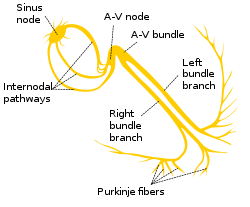The normal electrical pathway of the heart begins with the SA node then into the AV node. With these two rhythms the impulses are conducted from many more areas in the Atria other than the SA node. This leads the Atrium to quiver rather than a full contraction
Atrial Fibrillation(Picture 1) = an Arrhythmia that causes the heart to have a conduction or electrical issue that leads to an irregular Heart Rhythm. The QRS remains normalbut no P waves are present. The R to R is irregular, the PR interval is nonmeasurable. Some people tend to confuse A Fib with Normal Sinus w/ PACs due to the irregular R to R but do not take into account that Normal Sinus always presents with a P wave prior to every QRS and A Fib no P wave.
Due to the increased heart rate, Beta Blockers or Calcium Channel Blockers are often also prescribed to maintain the heart rate within normal limits
- A Flutter(Picture 2)= Unlike A Fib where the beats are chaotic and super irregular, the Atria are a lot more coordinated in A Flutter. Presenting with 2:1, 3:1 or 4:1 Flutters Waves for every QRS Complex
Complications for these two rhythms are the development of clots which form due to the excess blood left in the Atrium and not being able to completely empty due to the Fibrillation or Flutter waves. There is also a decrease in cardiac output
Treatment for A Fib/A Flutter are very similar. Due to the development of clots, Blood Thinners need to be prescribed(Coumadin, Eliquis, Pradaxa and Xarelto)
- Some patients need a “Cardioversion”(Picture 3), in which the MD attempts to shock the patient out of the current rhythm and into Normal Sinus. Prior to this procedure an Echo is usually done to check for clots. If the patient converts with a present clot, it could dislodge and the patient can Stroke
Maze Procedure(Picture 4)= The surgeon creates a pattern of incisions which them become scar tissue (the maze). The development of scar tissue does not allow the conduction of electricity in the Atrium and disrupts the pathway to the abnormal electrical impulses that occur with A Fib/A Flutter. This is typically the last procedure done when all else fails
- Ablation(Picture 5) = When Medications and Cardioversion do not work. A catheter is interested into the heart via an Artery. Using either Cryoablation or Radio Frequency the overactive tissue is destroyed. Sometimes more than one ablation is needed for it to be a success
Post Operative Open Heart Patients (Coronary Bypass Graft, Valve Repair/Replacements, etc.) tend to develop Rapid Atrial Fibrillation (A Fib with a higher ventricular rate) post op day 3-5. While some tend to use a a Cardizem or Esmolol Drip (Calcium Channel Blockers, or Beta Blockers) others use Amiodarone









Comments
Post a Comment